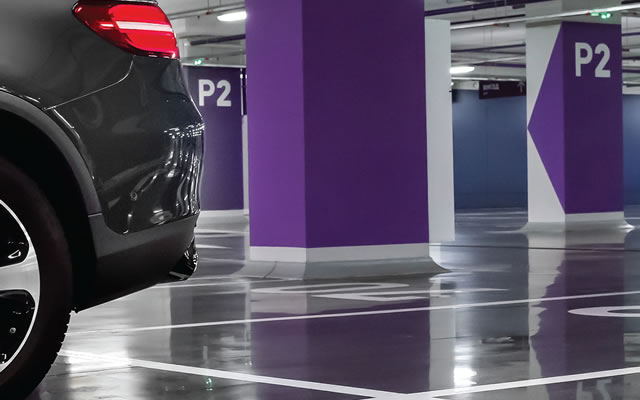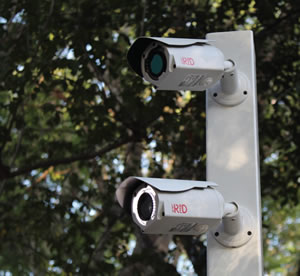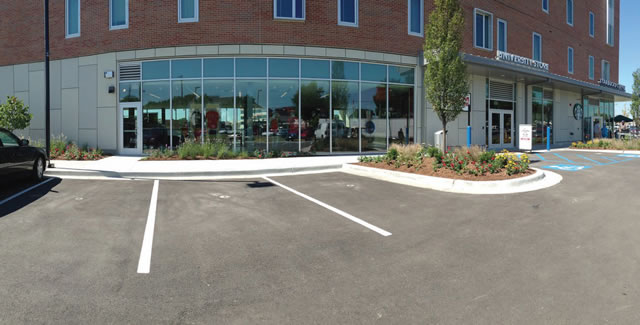Campus Parking Trends
Parking can be a headache for colleges and universities. It’s not always easy to provide convenient parking to
potentially thousands of students, faculty, staff, and visitors day
after day. However, in recent years, a number of new technologies
have been introduced to make parking more user-friendly
and manageable, and campuses have benefited greatly from these
advances.

Photo credit shablovskyistock
When it comes to parking technology and campus parking,
the name of the game is convenience. Recent advances to access
and revenue control equipment, parking guidance, license plate
recognition, and mobile payment have been game-changers for
colleges and universities.
Technology Trends
According to David Lieb, national director of Higher Ed Mobility
Planning for Walker Consultants, colleges and universities
are turning to technology to make parking more virtual and less
frustrating.
“Many are installing technologies that make the license plate
the parking credential,” says Lieb. “For instance, colleges are installing
license plate recognition (LPR) technology at entrances
and exits. LPR cameras can be attached to access gate systems or
stand alone, and when drivers enter the parking facility, the system
recognizes the plate and associates it with the appropriate permit.”
Virtual systems like this eliminate the need for hang tags,
which can save an institution thousands of dollars that would
otherwise go to purchasing those credentials, and replacing them
when, inevitably, they get lost. Vehicle-mounted LPR cameras
can be used for more efficient enforcement, allowing campuses to
do a better job protecting spaces for those who have properly paid.
LPR costs have come down significantly in recent years, which
has made the technology more attractive.
Parking guidance is another popular parking technology on
campuses across the U.S. Guidance systems utilize sensors that
monitor whether parking spaces are available or occupied and
transmit that information to LED signs located at parking facility
entrances and on aisles. The signs let drivers know exactly
how many spaces are available in a facility as well as on individual
floors, and that information is transmitted in real time.
“Colleges and universities love parking guidance technology
because it makes parking more efficient to find, so students and
teachers aren’t late for their classes,” says David Waal, executive vice president of Parking
Sense. “One California university
that installed parking
guidance found that the time
required to find a parking
space quickly dropped from
a half hour to five minutes.”
According to Waal, one
of the most exciting recent
parking guidance advances
has been the development of
mobile apps that can tell drivers
where they can find parking
and how to get to those
parking facilities. The apps
are connected to the campus
parking guidance system and
receive constant utilization
data, so drivers can find out where parking is available at that particular
moment.
“This is a terrific feature because it makes parking on campus
much more convenient,” says Waal. “It
also significantly reduces congestion on
campus roadways because people aren’t
driving aimlessly searching for parking.
Campus transportation managers love it
because they aren’t getting dozens of calls
a day asking for help.”
Parking software has also come a long
way in recent years and, according to
Gorm Tuxen, president of IPsens, the most
exciting advancement has been the introduction
of open IP parking systems. With
open IP, universities are able to customize
their software to meet their own individual
needs. And as campus parking needs evolve, or as the parking
technology suite grows, the software can be adjusted as necessary.
“There are a lot of different front-end solutions, including sensors,
access and guidance systems, and LPR,” says Tuxen. “It’s important
for campuses to utilize parking software that can be integrated
dynamically to the back-end system to bring everything
together and let all of the different technologies share data with
each other. You don’t want to be locked into a data management
system that’s linked to a particular hardware system.”
David Lieb agrees that data is an important consideration and
that many colleges and universities don’t have a firm grasp of
what their data can tell them.

Photo courtesy of Red LPR
“Campus parking organizations have much more data than they
often realize, or know how to use,” says Lieb. “Parking technology
is constantly collecting information about how many people are
parking every day, when parking facilities are busiest, and which facilities
are busiest. At the same time, bike-sharing and ride-sharing
programs are collecting user data, as are campus transit systems.
“Colleges and universities need to have systems and skilled personnel
in place to collect and analyze that data,” continues Lieb.
“When they do, they will find that they have a lot of valuable
information that can help them determine
how they can run their parking more efficiently,
whether it’s time to develop additional
parking, and whether other demand
management strategies could be beneficial.”

Photo courtesy of IPsens
Curb management is becoming a much more prevalent issue because campuses often
have many curb spaces and they need effective curb management strategies.
Curb Management
Another important parking trend for
colleges and universities is that curb management
is becoming a much more prevalent
issue. That’s because people traveling
to and from colleges and universities aren’t
just arriving in cars. In a campus setting
people are also relying on bicycles and bike-share services, ride-hailing services like Uber and Lyft, scooters, public transit and, of course, campus-sponsored shuttle services.
“Campuses may have a lot of curb space, and we are seeing a lot more interest in curb
management strategies,” says Lieb. “The intensity of demand is much higher in a campus
environment, and it’s imperative for colleges and universities to create strategies that allow
for all of these different modes of transportation to be able to share the same curbs.”
Roamy Valera, CEO US and Canada for PayByPhone, agrees that curb management
is essential for colleges and universities,
and he says that technology can play a
vital role. Mobile technology, in particular,
can help.
“A vital element of curb management
is convenience,” says Valera. “The
more convenient it is for drivers to access
parking, the more likely drivers are
to follow the rules. And when it comes
to convenience, connectivity is key.”
That’s where mobile payment apps
come in, according to Valera. In addition
to allowing drivers to conveniently
pay for parking, mobile payment apps
can also be used to manage permit
parking. The apps can also help with
enforcement by letting drivers know
when their parking sessions are over
and, if they don’t move their vehicles,
alerting enforcement officers. By managing
parking behaviors, the apps help
with curb management by assuring
that curbside areas are kept clear for
other modes of transportation.
David Lieb adds that good curb management
strategies become more
important as a campus works to reduce
the demands placed by single-occupancy
commuter vehicles, and people
shift to other modes—and employ
different first- and last-mile solutions.
Additionally, any new or improved
programs—such as carpool, vanpool,
and transit incentives—should be accompanied
by support services such as
guaranteed ride home programs.
“You don’t want students and staff to
feel trapped just because they don’t have
their own cars on campus,” says Lieb.
This article originally appeared in the November/December 2019 issue of Spaces4Learning.